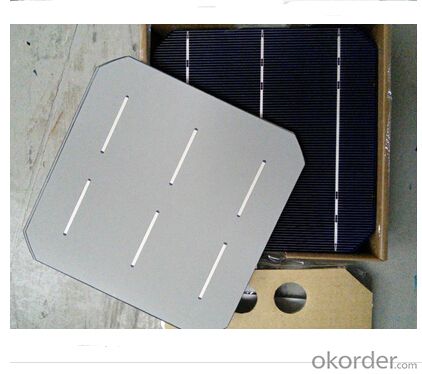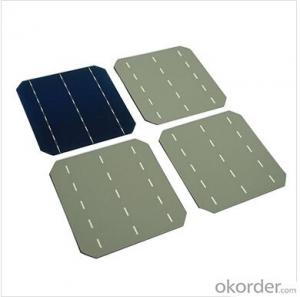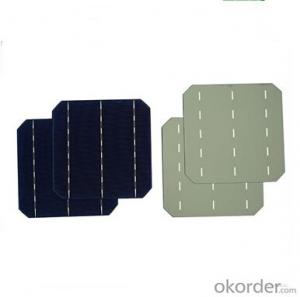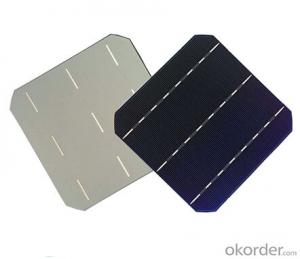Monocrystalline Solar Cells A Grade 17.417.6
- Loading Port:
- Shanghai
- Payment Terms:
- TT or LC
- Min Order Qty:
- 5000 pc
- Supply Capability:
- 80000 pc/month
OKorder Service Pledge
OKorder Financial Service
You Might Also Like
Monocrystalline Solar Cells A GRADE
Solar cells is made by solar wafer, it has three categories of solar cell right now, monocrystalline polycrystalline and thin film,These cells are entirely based around the concept of ap-n junction, which is the critical part of solar module, it is the part that can convert the light energy into electricity, the thickness is from 180um to 200um, with even busbars to conduct electricity, textured cell can decrease diffuse reflection; they are often electrically connected and encapsulated as a module. Photovoltaic modules often have a sheet of glass on the front (sun up) side, allowing light to pass while protecting semiconductor wafers from abrasion and impact due to wind-driven debris, rain, hail, etc. Solar cells are also usually connected in series in modules, creating an additive voltage. Connecting cells in parallel will yield a higher current;With high quality and stable quality. Our Cells can greatly improve the performance of Solar Modules.
Advantage of Monocrystalline Solar Cells
• High efficiency and stable performance in photovoltaic conversion.
• Advanced diffusion technique ensuring the homogeneity of energy conversion efficiency of the cell.
• Advanced PECVD film forming, providing a dark blue silicon nitride anti-reflection film of homogenous color and attractive appearance.
• High quality metal paste for back surface and electrode, ensuring good conductivity, high pulling strength and ease of soldering.
• High precision patterning using screen printing, ensuring accurate busbar location for ease with automatic soldering a laser cutting.
Specifications of Monocrystalline Solar Cells
Format : 156 mm × 156 mm ± 0.5 mm
Thickness: 210 μm ±40 μm
Front (-) : 1.5mm bus bars (silver),blue anti-reflection coating (silicon nitride)
Back (+) : 2.5mm wide soldering pads (silver) back surface field (aluminium)
Efficiency (%) Pmpp (W) Umpp (V) Impp (A) Uoc (V) Isc (A) |
18.20% 4.43 0.536 8.263 0.634 8.712 |
18.00% 4.38 0.535 - 8.188 0.633 8.701 |
17.80% - 4.33 0.534 - -8.112 ---0.632 ----8.652 |
17.60% 4.28 0.533 8.036 0.631 8.641 |
17.40% 4.23 0.529 8.005 0.630 8.591 |

FAQ
We have organized several common questions for our clients,may help you sincerely:
①What price for each watt?
It depends on the efficiency of the solar cell, quantity, delivery date and payment terms.
②How long can we receive the product after purchase?
In the purchase of product within three working days, We will arrange the factory delivery as soon as possible. The pecific time of receiving is related to the state and position of customers.Commonly 7 to 10 working days can be served.
③Can you provide the peripheral products of the solar panels, such as the battery, controller, and inverter? If so, can you tell me how do they match each other?
Yes, we can, we have two companies for solar region, one is CNBM International, the other is CNBM engineering Co.
We can provide you not only the solar module but also the off grid solar system, we can also provide you service with on grid plant.
④What is your warranty of solar cell?
Our product can promise lower than 0.3% open box crack, we support claim after opening the box if it has crackm color difference or sth, the buyer should give pictures immediately, we can not accept the claim after the solar cell has assembled to solar panel.
• Timeliness of delivery
• ⑤How do you pack your products?
We have rich experience on how to pack the solar cell to make sure the safety on shipment, we could use wooden box or pallet as buyer's preference.
New Way of Making Solar Cells Promises Cheaper Power
A new way of making solar cells promises a cheaper way to generate electricity from the sun and new ways to integrate solar power into other products. When the light comes in and is both directly absorbed by the wires, and some of the light bounces around in between the wires. In fact, the absorption enhancement that we see is in the range of 20 to 50 times the single-pass absorbance. The principles with the wire arrays is grow them on a supporting substrate, and peel them off inside a plastic sheet, so that the material has exactly the optical and electrical properties of a silicon wafer, but instead it basically has the mechanical properties of a flexible plastic sheet. Except that, the flexibility opens the door to potential new applications. For example, the solar cell could be built into roofing material, saving money on installation. Other ideas for new uses come from the physical form of Atwater's novel design.
The more wonderful thing about solar energy is that it's accessible and available everywhere in the world, from the cloudiest place in northern Europe to the sunniest place in north-central Africa to the Outback of Australia to South Asia. And in fact the use of solar energy is growing worldwide for that reason."
To make the solar cells greener and more efficient, The scientists used the bacteria Mycobacterium smegmatis. In fact,A mycobacterium is a type of pathogen that can cause diseases such as tuberculosis, but the species scientists utilized in the study is harmless and can be found in soil and cornflakes. It also produces the protein MspA, which can be used for numerous applications once it has been chemically purified.
After purifying the protein, Scientist combines it with a synthesized dye that is less toxic than traditional dyes. The protein-dye mixture is coated onto individual solar cells and tested with artificial sunlight to measure energy output.
The core idea is that the protein acts as a matrix for electron transfer for this dye that absorbs sunlight. We want the protein to be able to capture the electron that the dye gives out and then transfer that electron in one direction, thereby generating an electrical current.
The new dye-sensitized solar cells do not currently improve on the technology’s ability to convert sunlight into electrical current, but they are the first of their kind and could help low-cost solar cells become a more viable option for alternative energy applications.
This type of research where you have a biodegradable or environmentally friendly component inside a solar cell has not been done before, and the research is still in its early stages right now. But we have noticed that it’s working, and that means that the protein is not decomposed in the light and electric generating conditions. Because of that, we believe that we’ve actually made the first protein-incorporated solar cell.
- Q:What is the typical warranty for solar cells?
- The typical warranty for solar cells ranges from 10 to 25 years, depending on the manufacturer and type of solar cell.
- Q:How do solar cells impact job creation?
- Solar cells have a positive impact on job creation as they require a skilled workforce for the manufacturing, installation, and maintenance of solar panels. The growing demand for solar energy has created various job opportunities in sectors such as engineering, construction, and clean energy technology, thus contributing to economic growth and employment opportunities.
- Q:What are the advantages of monocrystalline silicon and polycrystalline silicon in solar power?
- In the use of solar energy, monocrystalline silicon and polysilicon also play a huge role. Although the current terms, to make solar power has a larger market, the majority of consumers to accept, we must improve the efficiency of solar cell photoelectric conversion, reduce production costs. From the current development of international solar cells can be seen that the development trend of monocrystalline silicon,
- Q:How do solar cells handle high winds or hurricanes?
- Solar cells are designed to withstand high winds and hurricanes due to their robust construction and installation techniques. The panels are securely anchored to rooftops or mounted on sturdy frames, ensuring they can withstand strong winds. Additionally, solar panels are tested and rated for wind resistance, with most systems being rated to withstand wind speeds of up to 140 miles per hour. Therefore, solar cells are designed to handle high winds and hurricanes with minimal damage or risk of detachment.
- Q:Can solar cells be used in space heating systems?
- Yes, solar cells can be used in space heating systems. Solar cells can convert sunlight into electricity, which can then be used to power heating systems. This can be done through the use of solar thermal collectors or by converting the electricity generated by the solar cells into heat using electric heaters.
- Q:Can solar cells be used in underwater vehicles or submarines?
- Yes, solar cells can be used in underwater vehicles or submarines. However, they have certain limitations due to the reduced availability of sunlight underwater. To overcome this challenge, the solar cells used in these vehicles are usually highly efficient and designed to operate even in low-light conditions. Additionally, the surface area of solar panels may need to be increased to compensate for the reduced sunlight intensity.
- Q:What is the impact of dust and dirt on solar cell efficiency?
- Dust and dirt can have a significant impact on solar cell efficiency. When dust and dirt accumulate on the surface of solar cells, they block sunlight from reaching the cells, reducing their ability to generate electricity. This decrease in solar cell efficiency can lead to a decrease in overall power output and, consequently, a decrease in the overall efficiency of a solar panel or system. Regular cleaning and maintenance of solar panels are necessary to ensure optimal performance and maximize energy production.
- Q:How does the solar cell work properly?
- When sunlight enters a certain structure, the photons provide the energy to activate the semicondcutore to generate power.
- Q:Can solar cells be used in indoor lighting applications?
- Yes, solar cells can be used in indoor lighting applications. However, their effectiveness may vary depending on the amount of sunlight available indoors.
- Q:Anybody ever heard of solar roll flexible solar panel?
- The flexible solar cells is more convenient to take with you, and also easy to charge as long as you do know how to use it properly.
1. Manufacturer Overview |
|
|---|---|
| Location | |
| Year Established | |
| Annual Output Value | |
| Main Markets | |
| Company Certifications | |
2. Manufacturer Certificates |
|
|---|---|
| a) Certification Name | |
| Range | |
| Reference | |
| Validity Period | |
3. Manufacturer Capability |
|
|---|---|
| a)Trade Capacity | |
| Nearest Port | |
| Export Percentage | |
| No.of Employees in Trade Department | |
| Language Spoken: | |
| b)Factory Information | |
| Factory Size: | |
| No. of Production Lines | |
| Contract Manufacturing | |
| Product Price Range | |
Send your message to us
Monocrystalline Solar Cells A Grade 17.417.6
- Loading Port:
- Shanghai
- Payment Terms:
- TT or LC
- Min Order Qty:
- 5000 pc
- Supply Capability:
- 80000 pc/month
OKorder Service Pledge
OKorder Financial Service
Similar products
New products
Hot products
Hot Searches
Related keywords





























